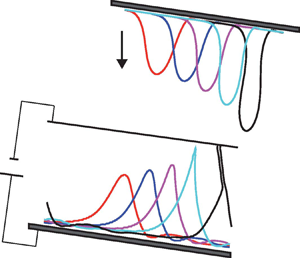Article contents
On the effect of electrostatic surface forces on dielectric falling films
Published online by Cambridge University Press: 13 November 2020
Abstract

The destabilization of a dielectric film flow due to an electrostatic surface force is investigated. A weighted residuals integral boundary-layer (WIBL) model is derived and validated against full numerical simulations. The equations of the WIBL model indicate that the electrostatic surface force contributes to the evolution equations in a similar mathematical way as the volumetric gravitational force. Contrary to gravity, an additional electrostatic contribution ( $\chi _2$) arises, whose impact increases nonlinearly with decreasing capacitor plate distance. This nonlinear contribution causes a fold of the branch of solutions of the dynamical system and, thus, the co-existence of a low amplitude solution that is stable against infinitesimal disturbances and an unstable high amplitude solution. In time-dependent simulations, the fold coincides with the limit in the parameter space beyond which a finite-time blow-up occurs with an unsaturated growth of the main wave hump leading to wave pinch-off and drop formation. Thus, a phase diagram can be constructed by tracking this fold. The shape of the main wave prior to blow-up depends on the electrostatic parameter
$\chi _2$) arises, whose impact increases nonlinearly with decreasing capacitor plate distance. This nonlinear contribution causes a fold of the branch of solutions of the dynamical system and, thus, the co-existence of a low amplitude solution that is stable against infinitesimal disturbances and an unstable high amplitude solution. In time-dependent simulations, the fold coincides with the limit in the parameter space beyond which a finite-time blow-up occurs with an unsaturated growth of the main wave hump leading to wave pinch-off and drop formation. Thus, a phase diagram can be constructed by tracking this fold. The shape of the main wave prior to blow-up depends on the electrostatic parameter  $\chi _2$. If this parameter is zero, the force is equivalent to a hanging film flow configuration and dripping occurs with a drop-shaped structure. With an increasing contribution of the parameter
$\chi _2$. If this parameter is zero, the force is equivalent to a hanging film flow configuration and dripping occurs with a drop-shaped structure. With an increasing contribution of the parameter  $\chi _2$, Taylor-cone waves occur prior to finite-time blow-up, leading to jetting. Finally, the transition from stable to unstable waves is investigated in terms of the two dimensionless electric parameters, the Reynolds, and viscous dissipation numbers. Imposing the most amplified wavelength, a transition border between stable solutions and jetting is identified.
$\chi _2$, Taylor-cone waves occur prior to finite-time blow-up, leading to jetting. Finally, the transition from stable to unstable waves is investigated in terms of the two dimensionless electric parameters, the Reynolds, and viscous dissipation numbers. Imposing the most amplified wavelength, a transition border between stable solutions and jetting is identified.
JFM classification
- Type
- JFM Papers
- Information
- Copyright
- © The Author(s), 2020. Published by Cambridge University Press
References
REFERENCES
- 7
- Cited by



